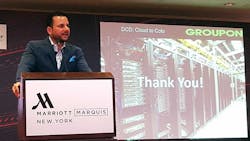NEW YORK – In the startup world, there are many accounts of companies running their servers in the cloud. But once those startups start to reach Internet scale, the story shifts, along with the infrastructure, as fast-growing companies move into their own data center facilities.
A case in point: Groupon, the e-commerce company known for its web coupon service. The company started life in the cloud, deploying its infrastructure on Amazon Web Services (AWS) and Salesforce to accommodate its rapid growth.
“Cloud absolutely makes sense for startups to work on an OpEx month-to-month basis rather than long-term CapEx,” said Harmail Chatha, head of Global Data Center Strategy and Operations for Groupon. “We made a strategic decision in 2011 to exit the cloud. We had reached a certain scale and maturity, and we wanted to control our infrastructure.”
Chatha described Groupon’s data center journey in a presentation at DataCenterDynamics Enterprise earlier this year. It’s not alone among companies moving off the cloud as they approach hyperscale status. Over the last two years, storage giant Dropbox has migrated 500 million customers off AWS and into data center space, much of it leased from wholesale data center providers.
Cost Considerations Drive Colo vs. Cloud Decision
Chatha didn’t itemize Groupon’s locations or providers, but the company recently leased 1 megawatt of space at a new facility in Sacramento operated by RagingWire Data Centers.
“Cloud makes sense for corporate IT,” said Chatha. “It absolutely makes sense for startups to work on an OpEx month to month basis rather than long-termCapEx. The biggest caveat with cloud is cost management. For us, cost was the leading driver (to shift to colo). When you get to spending $200,000 to $250,000 a month is when you need to evaluate your infrastructure.”
Chatha said a fixed data center is best for consistent workloads, but can be an inefficient environment, with many users underutilizing their capacity. “We wanted to optimize the stack and customize our infrastructure for our needs,” said Chatha.
Groupon moved some of its cloud-based infrastructure to RagingWire Data Centers’ new CA3 facility in Sacramento. (Photo: RagingWire Data Centers)
The move from cloud to a colocation environment “involves a lot of stakeholders, and requires a lot of planning,” said Chatha. “It’s a more efficient model. But you have to take a holistic approach to your entire infrastructure and its lifecycle.”
The transition from cloud to colo typically takes between six months and a year, Chatha said. The process includes developing the business requirements and then evaluating data center options, being sure to include the full cost of connectivity and disaster recovery and how they impact the overall project cost.
Groupon established five “buckets” of server configurations and workloads, and calculated the cost of traffic and energy for each bucket and scenario.
Groupon uses virtualization and containerization to boost its resource utilization, and runs on high-efficiency servers. It uses aisle containment to eliminate loss of cooling, and support high power densities.
“People are usually very content if they’re at 5kW a rack,” said Chatha. “We’re pushing rack densities of 20kW to 22kW per cabinet.”
Groupon runs full racks, using all 42U, but actively experiments with mixing and matching different server and workload profiles to get the most out of each rack. “We’re optimizing the power consumption in every rack,” said Chatha.
Hot Groupons May Seek The Edge
As Groupon continues to grow, Chatha said the company is focused on edge computing opportunities. “We want to place our hottest Groupons closer to the users,” he said, referring to the discount coupons that drive its business. Content delivery networks (CDNs) can cache content at the edge, but edge data centers offer additional capabilities.[clickToTweet tweet=”Groupon’s Harmail Chatha: Does it make sense for us to pay millions of dollars to host with our biggest competitor?” quote=”Groupon’s Harmail Chatha: Does it make sense for us to pay millions of dollars to host with our biggest competitor?”]
“The key difference is that (edge computing) offers compute and management of data,” said Chatha. “Not all of that traffic needs to come back to your core data center. You can process some of that at the edge.
“It’s all about performance and control,” he added. “This really is tuned to the demands of digital business.”
Chatha said there were also some business considerations in continuing to host at Amazon Web Services.
“We’re an e-commerce company,” he said. “Does it make sense for us to give millions of dollars to host with our biggest competitor?”
About the Author



